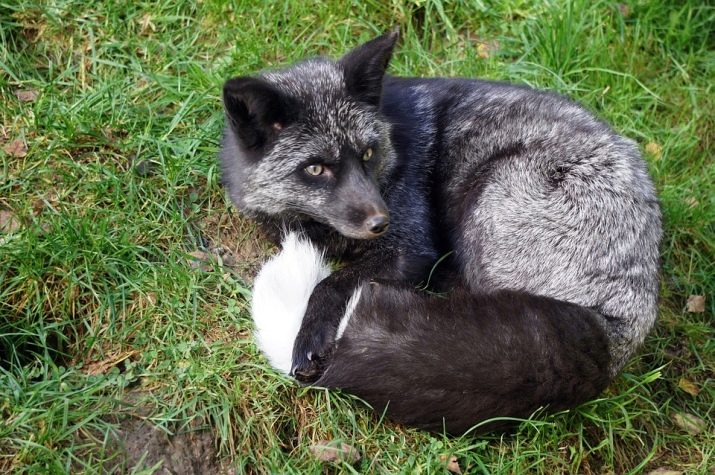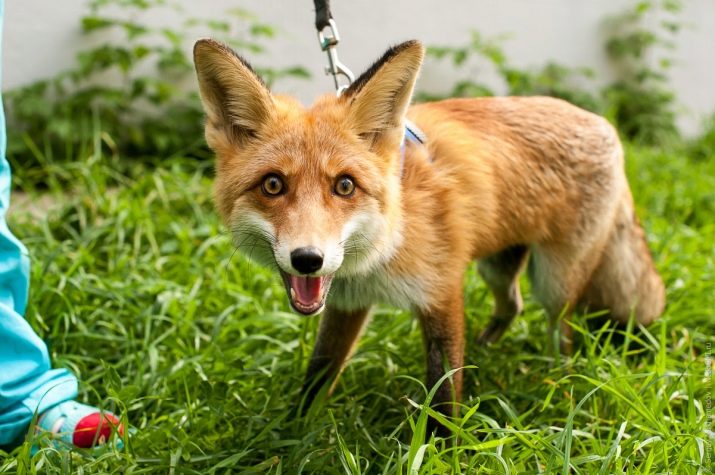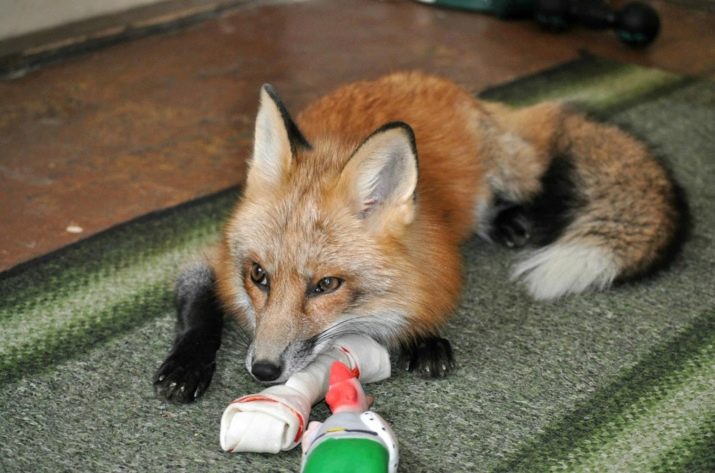Any pet needs proper care and proper maintenance. This applies not only to widespread cats, dogs, parrots and hamsters. By all rules, you must look after the domestic fox. This exotic animal looks very cute, you want to caress it, cuddle it. However, the appearance of domestic foxes is deceiving - they require special care and attention from their owners.

Types of domesticated animals
Today, exotic animals are brought not only in chic country houses, but also in ordinary city apartments. Many people prefer the beautifully-tailed beauties - foxes. These pets attract attention to themselves with a pretty appearance, perky disposition.
It's hard not to fall in love with such a charming creature. However, one must take into account the fact that he will have to be carefully and competently looked after. If the fox is not kept properly, it can lead to sad consequences.
People who want to get such a furry friend are interested in the question: which foxes are considered tame and domesticated? Let us consider in detail which breeds can be kept at home.

Silver fox
At one time, scientists conducted many experiments on the domestication of wild foxes. As a result, it turned out that the silver foxes are most susceptible to this process.
Beautiful black fox is tamed easily and quickly. She remembers her master. If you provide such a chic pet with all the necessary conditions, then in captivity he will feel great.


The length of the silver fox can reach a mark of 60-90 cm.It is characterized by a chic fluffy tail, which can grow up to 60 cm. The average weight of a silver fox is 10 kg.
The fur may have a different color. Some individuals have exclusively black color of wool and the tip of their tail contrasts with a white color. There are individuals whose fur is unobtrusive brown or bluish shade, and their sides are gray-ash.
Specialists strongly recommend buying a silver fox puppy in a specialized nursery or pet store. If the person who sells such an animal does not have all the necessary documents, then it is better not to take the pet.

Silver fox is a calm individual. If aggression does not come from a person and the animal does not feel danger, then it will not hide and fear, it will easily make contact. The movements of the silver fox are calm, unhurried. If you scare her, she will immediately stretch her fluffy tail and run away with incredible speed.

Common redhead
In Russia, the usual red fox also belongs to tame animals. The color of the coat of this pet can have many different shades. There are both saturated red and grayish individuals. The classic and most common coat color is white or light yellow chest and stomach, the tips of the legs and ears are black, and the tip of the tail is usually snow-white.
Artificial domestic red foxes can weigh from 10 to 15 kg. Their forest relatives grow more miniature and neat, their average weight is only 5-6 kg.
Common red fox is very energetic and perky pet. She is playful, has a strong immunity, and therefore rarely gets sick.


Fenech
The desert fennec fox is another representative of foxes that can be kept as pets. It is pointless to compare this fox with ordinary dogs or cats, but nevertheless they have certain common features. Phoenixes are about the same size as small cats. Their habits and behavior patterns are also similar.
Behind the desert foxes you can see the slight detachment characteristic of domestic cats. From dogs, these animals adopted playfulness and energy.
Fenech fox can seem like a real plush toy, but we must not forget that this is a wild beast. Complicated care for such pets is usually not required. They can even be accustomed to the tray, however, rarely does without periodic misses here.


Pros and Cons of Content
When starting a domestic fox, you should remember that this is a very big responsibility. Such an exotic pet has little to do with familiar cats and dogs, so you should not rush to purchase it. First you need to understand all the pros and cons of the content of such a beast.
Consider the benefits of keeping a domestic fox.
- This is a very active, curious and cheerful pet. Foxes love to play, you will not get bored with them. This is a real find for an energetic person.
- Domestic foxes are considered loyal animals. They are very fond of human affection and warmth. Many of them very quickly get used to their master, love him and are not afraid. In these qualities they are often compared with dogs.
- Typically, domestic foxes quickly and seamlessly adapt to a variety of food options. Their maintenance is not expensive.
- This is a very beautiful pet. It is the external attractiveness that prompts many people to get a home fox.
- Some types of domestic foxes can be accustomed to the tray like cats or dogs. Of course, you will have to spend a lot of time and patience on this learning process, and misses are not excluded in the future.



Cons of keeping a domesticated fox.
- Any domestic fox is a source of strong and pungent odors, which can not be called pleasant. Because of this, soon aromas take root in the home, which neither the household nor their guests like.
- Any domestic fox will mark its territory. Many people think that this problem can be avoided if you have a female, but this is not so. Females will also mark their possessions.
- The fox is a predatory animal. With the onset of night, she can begin to scream loudly, specifically, interfering with sleep at home. In certain situations, it can painfully bite a person.
- The pets in question can jump very high. This is especially true for miniature Fenechs. Often this feature of foxes creates many problems in their maintenance of the house.
- We must not forget that the fox is a burrowing animal, therefore, the owners will have to be prepared for the fact that she will constantly dig. The pet will do this on the couch, and on the floor, and on any other surfaces.
- Managing the behavior of a fox can be very difficult. This is an independent animal, it is not always possible to predict the course of his thoughts. You can always expect surprises from a fox.
- As mentioned above, you can train a fox in a house tray, but it is very difficult and not always successful. It will take a long and hard time to train the pet, while maintaining patience.
- If other pets live in the house, for example, mice, hamsters, rats, rabbits or chinchillas, the owners will have to understand that they will definitely not become friends with the fox. The listed animals are prey for her.
- Do not forget about the predator genes, therefore, keeping a fox in a house where young children live is risky.



Only after weighing all the pros and cons of the content, it is worth getting a domestic fox. You need to be prepared for all the difficulties that may arise when such a pet lives at home.
Nature and behavior
When acquiring such a beautiful and unusual pet, it is necessary to take into account all the features of its character and behavior. Domesticated foxes - animals are independent, wayward, but at the same time show confidence in their master. They can seamlessly adapt to a person’s mood. Red-haired beauties do not like to be alone, which once again confirms that they have a lot in common with dogs.
Domestic foxes are smart and have an excellent memory. With them you can easily and seamlessly make contact. A fox can be obedient and friendly if you treat her with kindness and love. But punishing a pet is undesirable. Foxes are vindictive and can subsequently take revenge on the person who punished them or reacted with malice.

How can fox dogs begin to wag their tail. This behavior is a signal that the pet is ready to play and frolic. If a red-haired beauty substitutes a tummy, this means that she shows complete confidence or wants to make peace with a person. If the fox pressed its ears, this indicates that it is afraid of something.
With manual foxes you can walk on a leash. True, experts advise going for walks with such an animal in the evening. Unfortunately, the smell of foxes can attract dogs of hunting breeds, which also go for a walk. These circumstances can lead to certain problems.

The fox is playful and friendly. Like a cat, she loves to jump into empty boxes, rush after the ball. Neighborhood with other pets will not bring problems if the latter are large or medium in size. Adult fox and cat are unlikely to cause each other interest. A fox can show aggression if it rushes to protect its offspring.
If a small puppy or kitten lives at home, then for a fox, they can become good friends. Often these animals go to bed together, play together and warm each other.
There is usually a distance between domestic foxes and dogs. They can make friends, especially if they live in the same territory from an early age together.

Growing conditions
For a fox of absolutely any breed, it is necessary to organize conditions of detention as close as possible to its natural environment. Only in optimal conditions can we talk about good health and the development of an exotic animal. Consider how to properly maintain a fox at home.
- First you need to find a good veterinarian, who agrees to deal with such an unusual pet. Chanterelles will need timely vaccinations, it is important to control the state of her health - you can’t do without a specialist.
- Twice a year, an animal blood test is recommended. According to the revealed results, the nutrition of the domestic fox is adjusted.
- For such an animal, it is very important to equip a high-quality and comfortable aviary of optimal height. It must be made of a durable and wear-resistant material that will not fail too quickly. In the aviary, the animal must be closed for a time when the owners leave the house. All foxes are big lovers of gnawing and digging, so it is advisable to make a cage out of metal.
- In the aviary, it is desirable to equip a den that imitates a hole. There the animal will be able to hide.
- For the toilet, it is best to choose a tray for dogs. You can fill in sawdust or a special filler.
- All items that break easily and are fragile need to be removed away from the fox, if she is allowed to move freely around the apartment. It must be remembered that this pet can jump very high.



The fox can be kept in the aviary on the street. But he must have walls, a roof and a floor. In a street aviary should be placed:
- container filled with digging sand;
- shelves on which the animal can climb;
- the den where the fox can retire;
- toilet tray;
- clean bowls with water and food.
On the street, a fox enclosure is recommended to be installed in a calm, secluded place. It’s good if it is away from neighbors, otherwise the nightly “songs” of the animal can outrage them.



Often foxes in an apartment are relocated to live on a balcony. This is a good solution for a simple fox, but a desert Fenech will feel comfortable only in conditions where it is dry and warm (about +20 degrees) year-round.
Ideal conditions for domestic fox - a separate room or part of it with a furnished partition. Feneks love to bury themselves in the sand and do it amazingly quickly, so it’s better to provide such foxes with the indicated bulk material to realize his instinct.


Proper care
A fox cannot be called an overly demanding animal, but you still need to properly care for it. The coat of these pets is beautiful, lush. It is recommended to comb it with an ordinary brush for pets. You can buy it at any pet store.
Phoenixes love to be combed, so this procedure should not be neglected. Combing a fox, you can not only give her pleasure, but also establish close contact.
Many breeders are interested in whether to bathe a domestic fox. There is no urgent need for this, but if the pet is very dirty, it must be washed using a special hypoallergenic shampoo for dogs. It is advisable to choose a product that does not have fragrances.
Bathing a fox more than 1 time per month is not necessary. Often you can only wash the paws of the animal. For example, after winter walks, you should wash the paws of the fox with Shampoo shampoo.


Do not forget about antiparasitic treatments, protection against pyroplasmosis, which is transmitted by tick bites. It is necessary to monitor the condition of the four-legged friend. If the fox has lost appetite, dry nose, frequent sneezing, tears flowing from the eyes - these are bad signals that indicate that the pet should be shown to the veterinarian as soon as possible.

What and how to feed?
A fox is a predatory animal, so its nutrition should be protein. In nature, these animals often eat berries, plant roots and wild fruits - they get vitamins from these products. To ensure that the nutrition of the domestic fox is balanced, the following ingredients should be on the menu:
- lean meat - chicken, beef, turkey (cut into pieces and poured with boiling water);
- offal: meat, heart, liver, tripe, chicken heads;
- boiled fish without bones;
- dairy products (foxes should be given fresh milk);
- cereal cereals;
- waste of flour or oil production, introduced into the feed: cake, bran;
- eggs
- fruits without seeds and seeds;
- vegetable purees from carrots, beets, cabbage;
- garden, forest berries;
- dry and wet food for dogs of the premium or super-premium categories (foxes should not be given such food on an ongoing basis).
At least once a week, the fox should be given live small rodents - in their natural habitat this is their main food. Access to water should be unhindered.




Some foods can cause serious damage to the health of a domestic fox, including the death of a pet. Consider what you can not give:
- bread (you can only give black and dried);
- fish: blue whiting, hake, pollock, pollock, hake;
- pork;
- any sausages;
- plum, peaches, persimmons, citrus fruits;
- any confectionery;
- fat collected after frying meat;
- yeast dough;
- bones of poultry and fish;
- potatoes, peppers, avocados, broccoli, mushrooms;
- vitamin complexes for people containing iron.



Foxes are prone to overeating and obesity, therefore, their nutrition should be monitored as closely as possible. Experts recommend feeding these pets in small portions, at least 3 times a day.
If you provide a domesticated chanterelle proper and balanced diet, she can live up to 20 years at home. In the natural environment, these animals live on average about 7 years.

Parenting and games
As with any other pet, you need to speak with the fox in the language of love and understanding. Despite a sufficient number of similarities, the fox should not be confused with the dog. The owners will have to be patient, especially in the first year of life of the animal in the house.
It is necessary to engage in the upbringing of the fox from the first days of its appearance in the home. This business should not be postponed for later. The animal must learn the command "fu". It is necessary to train and educate the fox by the method of "gingerbread and the absence of gingerbread." Simply put, it is impossible to punish the animal for not fulfilling the command.
Instead, he simply does not have to be given a treat. If the fox has completed what was required of her, she must be rewarded.

Experienced professionals recommend resorting to exclusively to non-contact animal punishment methods. If you act physically on a domestic fox, it will certainly move away from the person, lose confidence in him. Contact can be lost forever and irrevocably, so you do not need to beat the pet and scream at him.
As mentioned above, foxes have excellent memory and good intelligence. For some offense, the animal can simply be closed in a cage / aviary or skipped one meal. Due to such actions, the fox will quickly learn a lesson. You can also clap your hands and shout a little if the predator was caught at the "crime scene", but such actions will be useless if you perform them after the beast has done something.
The pet must have enough toys so that it does not rush to spoil other things in the house. The latter is better to hide away from the fox.


Foxes - predatory animals, night hunters. In the natural environment, they are active at night, which in home maintenance can be a big problem. You can tame and transfer the animal to day mode as follows: load it with games and activities to such an extent that by night he has no strength or energy left. This is where a large number of toys come in handy with which the pet will be able to practice all day.

To learn the fox new teams should be careful, without unnecessary imposition. You should not put pressure on this animal - foxes are independent and do not tolerate when they are forced to do something against their will. Classes and training should be of interest to the pet, then things will go faster and more fun. The main thing is not to behave aggressively towards the animal.If you treat him with malice, the relationship will be ruined, training will be futile.
If you can’t raise the animal yourself, it is better to contact an experienced specialist.

The following video will tell you about the features of keeping a fox home.










